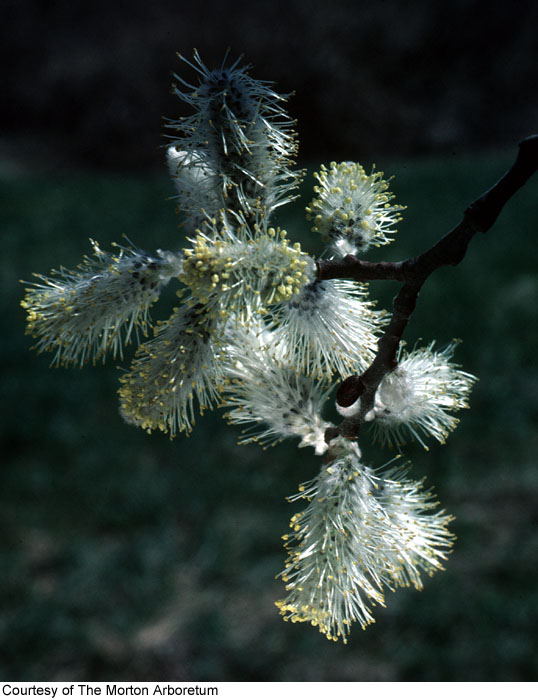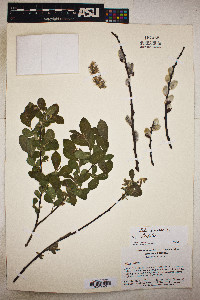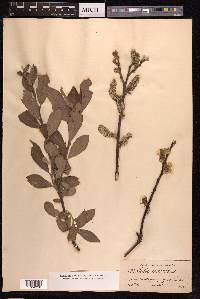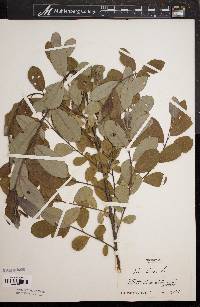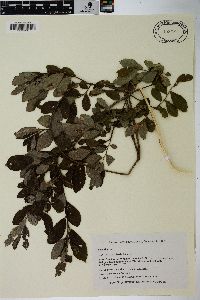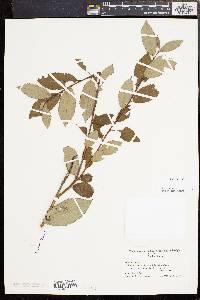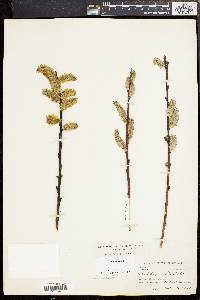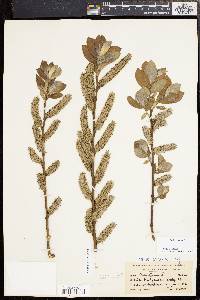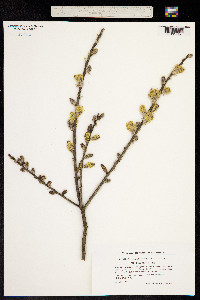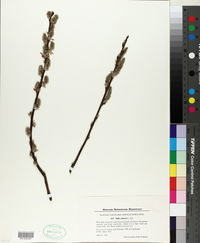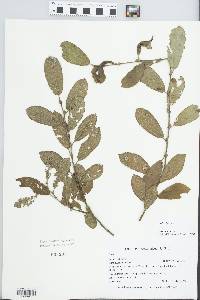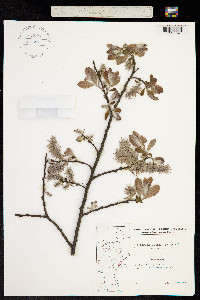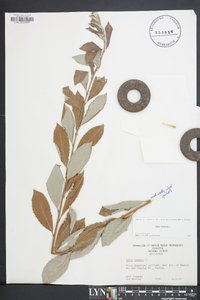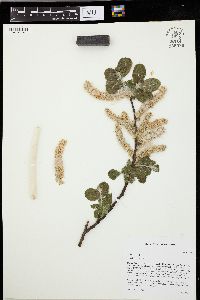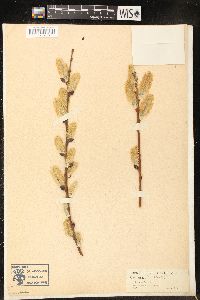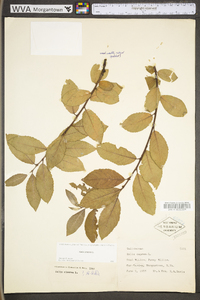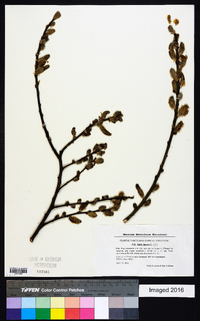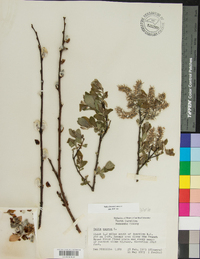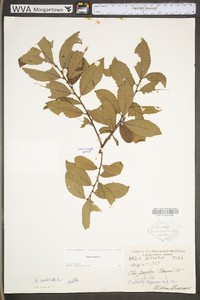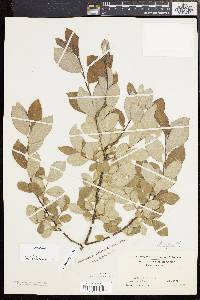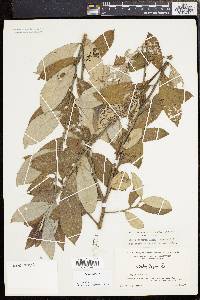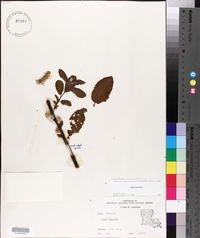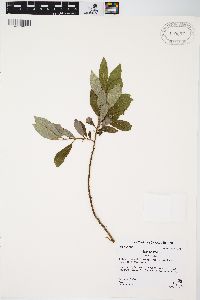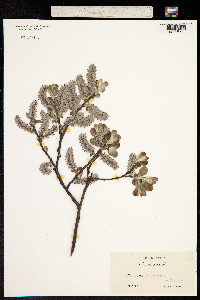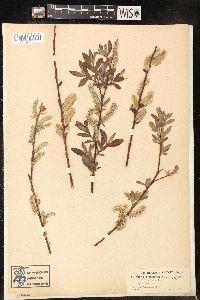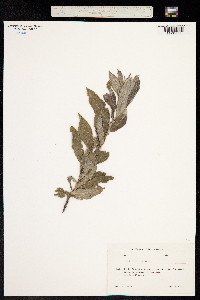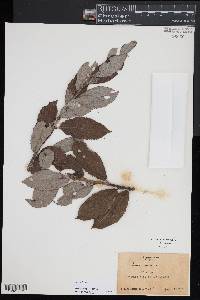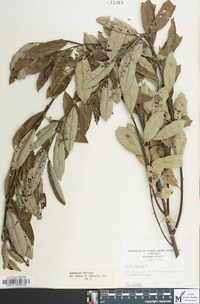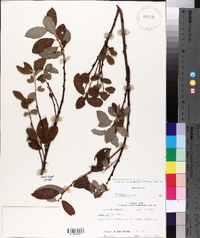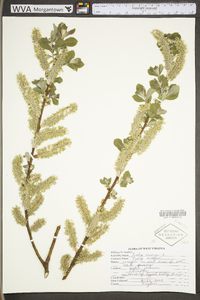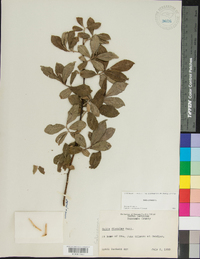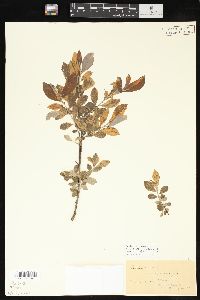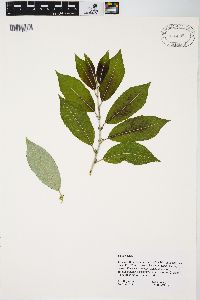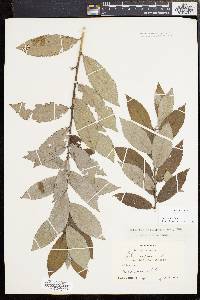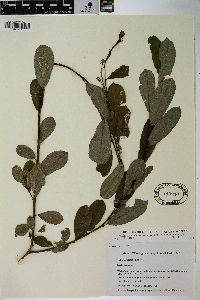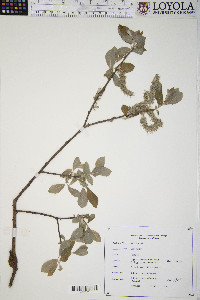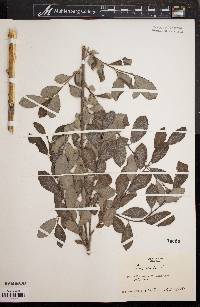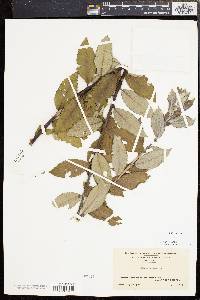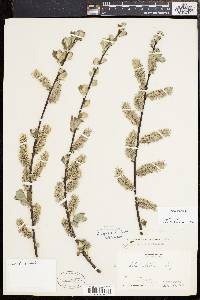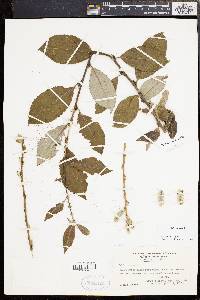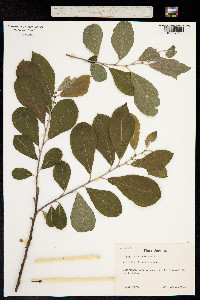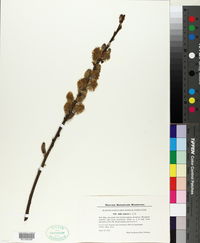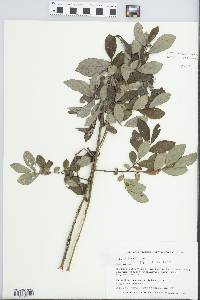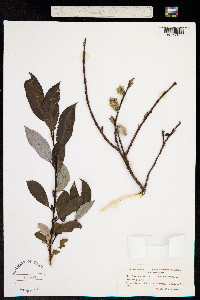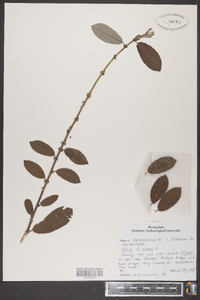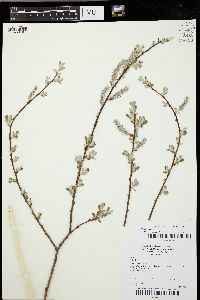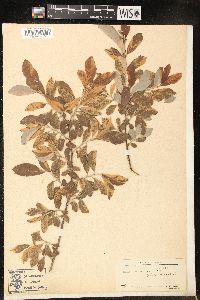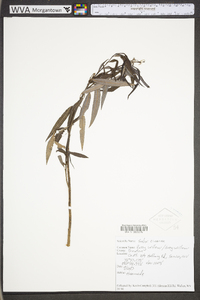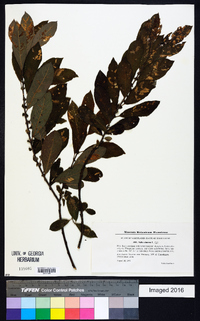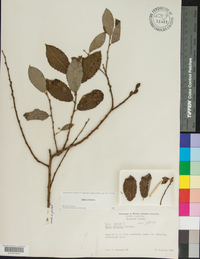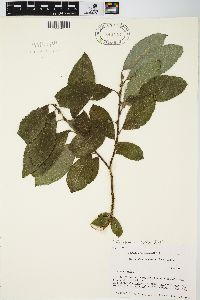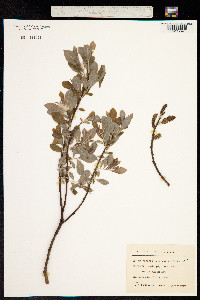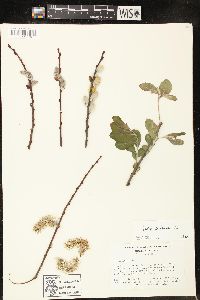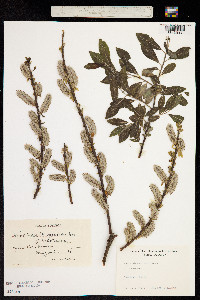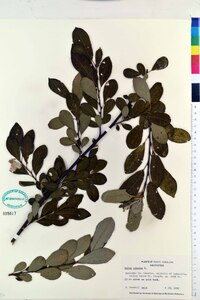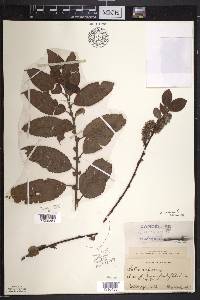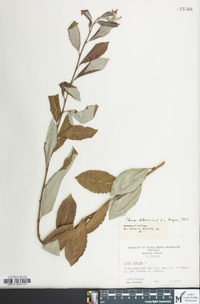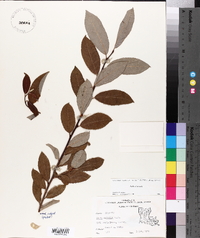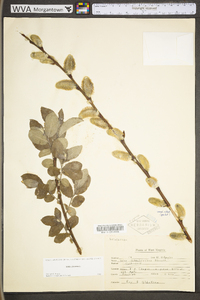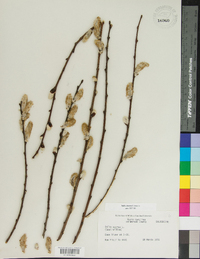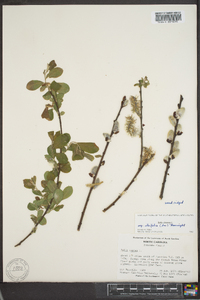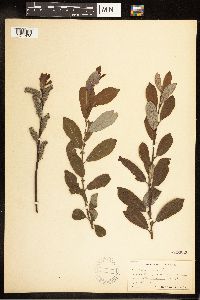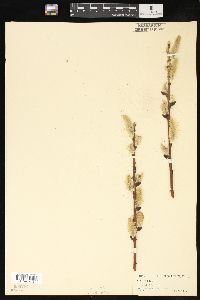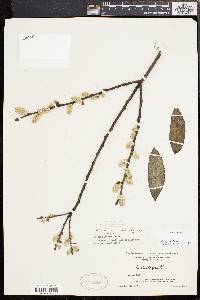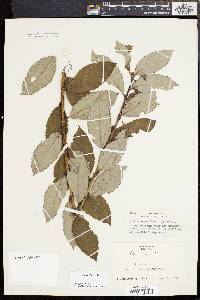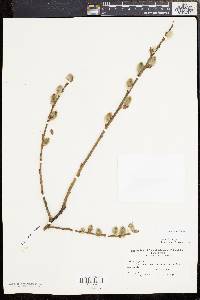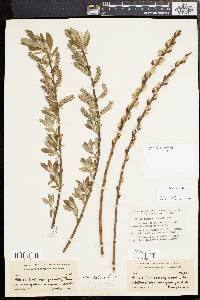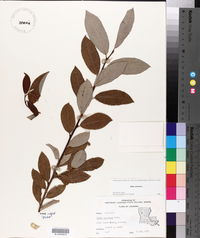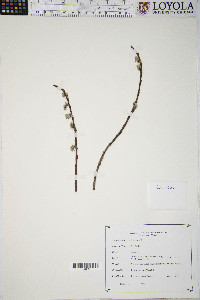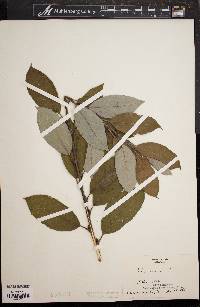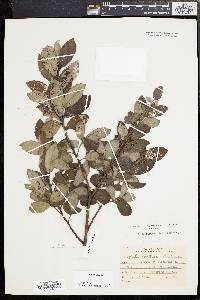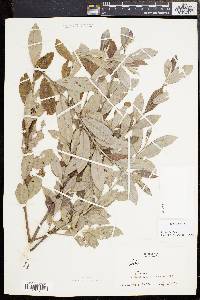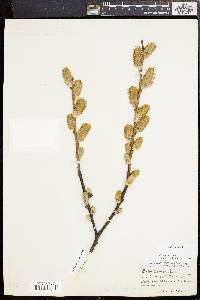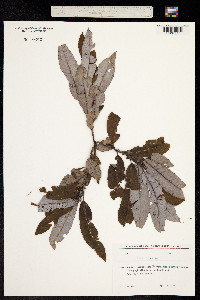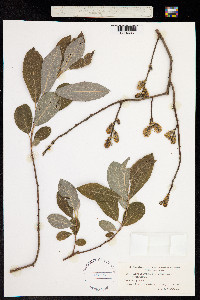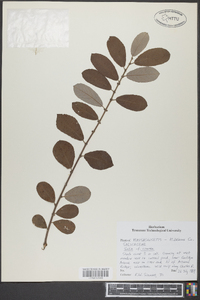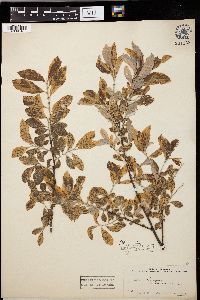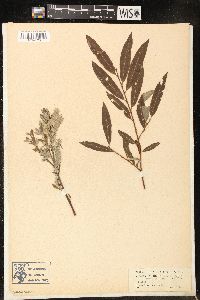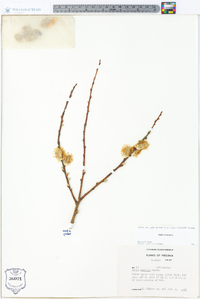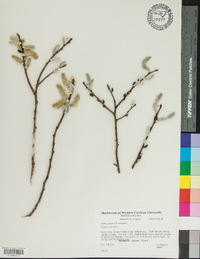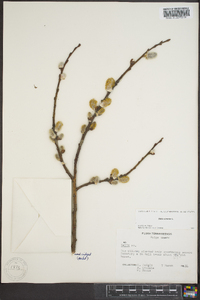
|
|
|
|
Family: Salicaceae
Large Gray Willow
|
Shrubs, 3-7 m. Stems: branches brownish, not glaucous, pilose, villous, or tomentose to glabrescent, (peeled wood with striae to 62 mm); branchlets yellow-brown, pilose, velvety, or densely villous. Leaves: stipules rudi-mentary or foliaceous on early ones, foliaceous on late ones, apex acute or rounded; petiole convex to flat adaxially, 4-15 mm, tomentose adaxially; largest medial blade elliptic, broadly elliptic, oblanceolate, or obovate, 65-105 × 22-52 mm, 2-3 times as long as wide, base convex or cuneate, margins slightly revolute, entire, crenate, or sinuate, (glands submarginal), apex acuminate or convex, abaxial surface glaucous, tomentose, hairs erect or spreading, curly, adaxial dull or slightly glossy, pubescent or tomentose; proximal blade margins entire; juvenile blade yellowish green, sparsely to densely tomentose abaxially, hairs white. Catkins flowering before leaves emerge; staminate stout or subglobose, 26-39 × 12-26 mm, flowering branchlet 0-5 mm; pistillate densely flowered, stout or subglobose, 27-54(-75 in fruit) × 4-15 mm, flowering branchlet 1-5(-10) mm; floral bract dark brown, black, or bicolor, 2-3 mm, apex acute or convex, abaxially hairy, hairs straight. Staminate flowers: adaxial nectary oblong or ovate, 0.5-1 mm; filaments distinct, glabrous or hairy basally; anthers yellow or purple turning yellow, ellipsoid or shortly cylindrical, 0.7-1 mm. Pistillate flowers: adaxial nectary oblong or square, 0.4-1 mm, shorter than stipe; stipe 1.2-2.7 mm; ovary pyriform, long-silky, beak slightly bulged below styles; ovules 12 per ovary; styles 0.2-0.5 mm; stigmas slenderly or broadly cylindrical, 0.3-0.6 mm. Capsules 5-5.6 mm. 2n = 76. Flowering mid Mar-late May. Stream shores, mesic woodlands, gravelly or sandy beaches, waste ground; 0-700 m; introduced; Ont.; Ala., Conn., D.C., Ga., Iowa, Ky., La., Md., Mass., Mich., Mo., N.J., N.Y., N.C., Ohio, Pa., R.I., S.C., S.Dak., Tenn., Utah, Va., W.Va., Wis.; Eurasia. The Ohio occurrence of Salix cinerea is based on information from T. Cooperrider (pers. comm.). Salix cinerea and S. atrocinerea are very closely related. Their occurrence in the flora area, as naturalized introductions, is not well understood, probably because they usually are introduced under the name S. caprea, and that species often is not treated in North American floristic literature (e.g., C. K. Schneider 1921; M. L. Fernald 1950). They probably are introductions of long-standing brought to the New World for their value as ornamentals and bee-plants. Salix atrocinerea was first documented in the southeastern United States (G. W. Argus 1986) after plants with ferruginous hairs and prominently striate wood were found in North Carolina; since that time, it has been found in other states and provinces. In the northeastern states, S. atrocinerea and S. cinerea are thought to be invasive species. The species do reproduce by seed and hundreds of seedlings were observed in a drained reservoir (A. Zinovjev, pers. comm.) and on sandy pond shores (T. Rawinski, pers. comm.), where they are thought to compete with native species. The presence of long, prominent, striae on the peeled wood of 4-5 year old branches is commonly used in European literature (K. H. Rechinger 1993; A. K. Skvortsov 1999) to separate Salix cinerea and S. atrocinerea from S. caprea etc., in which the wood is smooth or with fewer, shorter striae. In the flora area, long striae also occur in S. bebbiana, S. discolor, and S. humilis, but usually they are not as long as or as prominent in S. cinerea and S. atrocinerea. Some floras (e.g., F. Martini and P. Paiero 1988) use the relative prominence of striae to separate S. cinerea and S. atrocinerea, but their separation remains difficult. The presence of ferruginous hairs on the leaves of S. atrocinerea is the best diagnostic characteristic, but they are not always present or easily observed. For a comparison of these species, see the key to species under subg. Vetrix. For further discussion of morphologies, see Salix ×smithiana Willdenow [p. 132] and 76. S. discolor.
Shrub, sometimes tree-like 3 - 6 m tall Leaves: alternate, on leafstalks to 1 cm long, dull green above, densely gray- to bluish gray-hairy beneath, 5 - 9 cm long, elliptic or egg-shaped to lance-shaped with a tapering to rounded base and pointed tip, irregularly revolute (rolled downward along the margins), and round-toothed to slightly saw-toothed. Flowers: either male or female, borne on separate trees (dioecious) in hairy catkins. The catkin is nearly stalkless with four to seven bracts at the base. Female catkin greenish with dark brown scales, 2 - 3 cm long, and cylindrical. Ovary hairy. Male catkin white or silvery with dark brown scales, 2 - 5 cm long, egg-shaped to cylindrical, and fuzzy. Stamens two, with yellow anthers. Filaments 5 - 8 mm long and hairless (except at base). Fruit: a capsule, in elongated clusters, light brown, to 8 cm long, flask-shaped, and slightly hairy. Seeds have long, white, silky hairs attached. Bark: dark grayish brown, becoming fissured with age. Twigs: stout, gray to reddish brown, prominently grooved (seen when bark is removed), densely hairy for the first two years, becoming hairless. Buds: brown, egg-shaped, pointed, hairy, becoming hairless. Form: rounded or flattened and branching basally. Similar species: In the Chicago Region, Salix cinerea differs from most other willows by having hairy leaf undersides and downward-rolled (revolute) leaf margins that are not distinctly toothed. Salix caprea, which is very similar, has hairless twigs (except twigs within their first year) and wider leaves. Also, the wood under the peeled bark of S. cinerea is grooved, while the wood of S. caprea is smooth. Flowering: May, before the leaves Habitat and ecology: Introduced from Europe and frequently planted. Characteristic of moist sites. The first specimen collected locally was in DuPage County, Illinois, in low ground near a small creek. The Porter County, Indiana collection was made along the bike trail east of Mineral Springs Road. The Racine County, Wisconsin collection was made at Delmonte Lake, along a dirt road north of Honey Creek. Occurence in the Chicago region: non-native Notes: Florists sell branches of male catkins from both Salix cinerea and S. caprea during Easter as the common Pussy Willow. Etymology: Salix is the Latin word for willow. Cinerea is the Latin word meaning ash-colored. Author: The Morton Arboretum With more tomentose, narrower lvs than S. caprea, acute at both ends, is similarly used and rarely escapes. The long prominent ridges on decorticated wood are distinctive. Gleason, Henry A. & Cronquist, Arthur J. 1991. Manual of vascular plants of northeastern United States and adjacent Canada. lxxv + 910 pp. ©The New York Botanical Garden. All rights reserved. Used by permission. |

